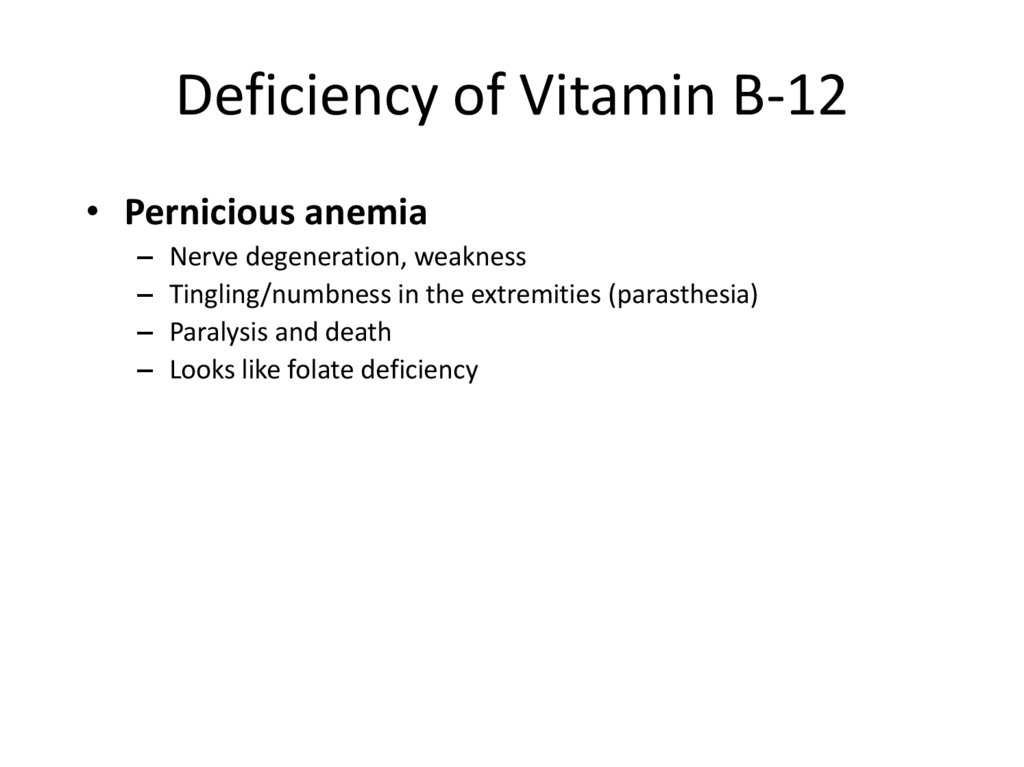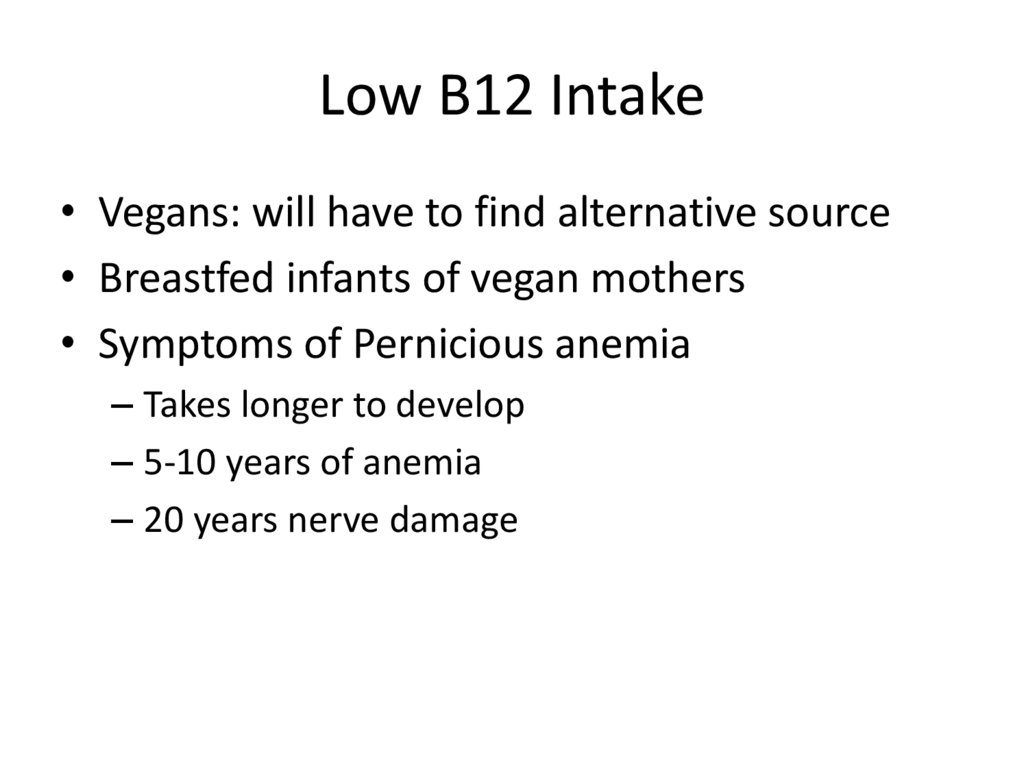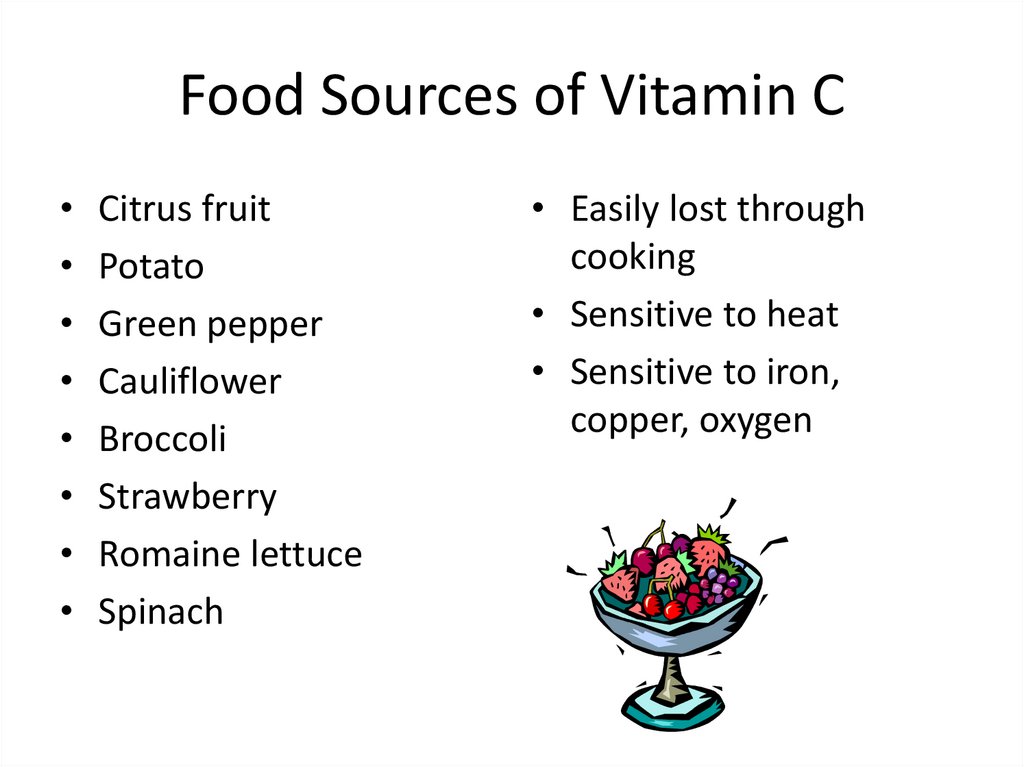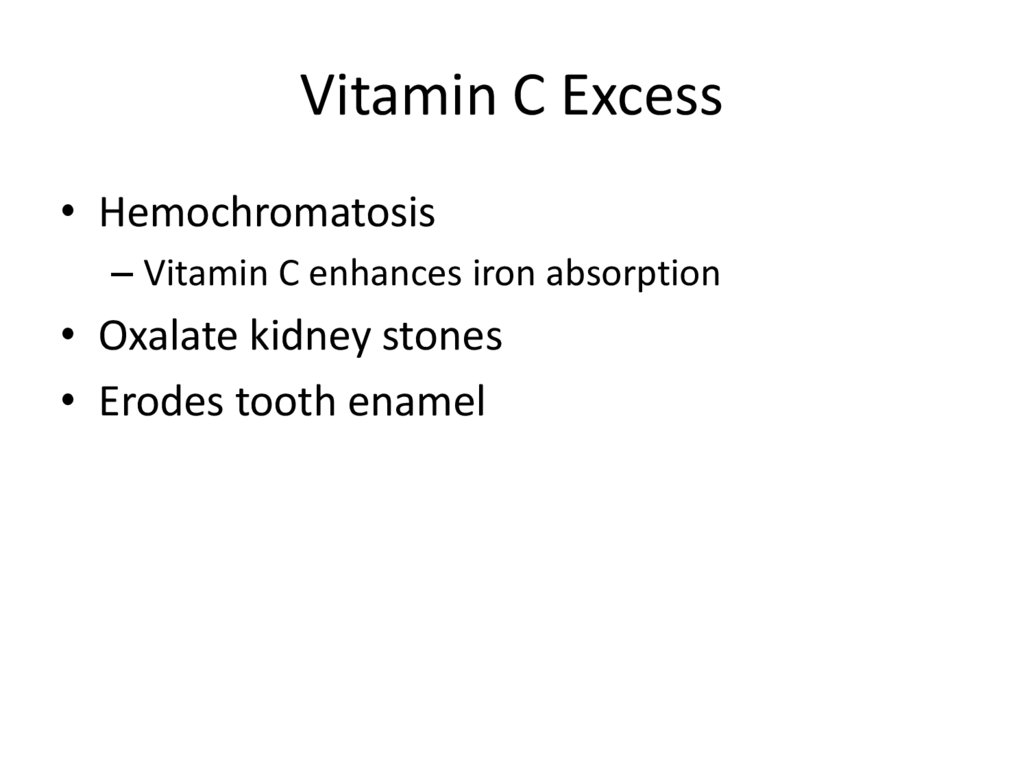Similar presentations:
The water soluble vitamins
1.
The Water Soluble Vitamins2.
Overview of Water-Soluble Vitamins• Dissolve in water
• Generally readily excreted
• Subject to cooking losses
• Function as a coenzyme
• Participate in energy metabolism
• 50-90% of B vitamins are absorbed
3.
B Complex Primary Functions• Energy metabolism
– Thiamin (B-1), Riboflavin (B-2), Niacin (B-3),
Pyridoxine (B-6), Biotin, Pantothenic Acid
• Red blood cell synthesis
– Folate, B12, B6
• Homocysteine metabolism
– Folate, B12, B6
4.
Thiamin• Part of nerve cell membranes—synthesize and
regulate neurotransmitters
• Functions in energy metabolism
5.
Thiamin Deficiency• Thiaminase found in raw fish also in tea and
coffee
– Destroys thiamin
• Heavy alcohol consumption with inadequate
food consumption ; alcohol interferes with
absorption (Wernicke-Korsakoff syndrome);
poor and elderly at risk for not eating
sufficient energy
6.
Thiamin Deficiency• Beri Beri
• Impaired muscle contractions
• Impaired cardiac function, edema and muscle
twitches
• Decreased neurological function and memory
loss
7.
Wet and Dry BeriBeri8.
Food Sources of Thiamin• Wide variety of food
• Pork, meat, cereal
• Enriched breads and grains/ whole grains
• Green beans, milk, orange juice, organ meats,
peanuts, dried beans and seeds
9.
Riboflavin (B2)• Coenzymes
• Participate in many energy-yielding metabolic
pathways
– Fatty acids broken down and burned for energy
10.
Deficiency of Riboflavin• Ariboflavinosis
– Glossitis, cheilosis, seborrheic dermatitis,
stomatitis, eye disorder, throat disorder, nervous
system disorder
11.
Ariboflavinosis12.
Food Sources of Riboflavin• Milk/products
• Enriched grains
• Ready to eat cereals
• Liver
• Oyster
• Brewer’s yeast
• Vegetables (asparagus, broccoli, greens)
• Sensitive to uv radiation (sunlight)
Stored in paper, opaque plastic containers
13.
Niacin (B3)• Nicotinic acid and nicotinamide
• Coenzymes
• Important for fatty acid synthesis
14.
Deficiency of Niacin: Pellagra• 3 Ds
– Dementia
– Diarrhea
– Dermatitis (worse with sun exposure)
• Poor appetite, weight loss, weakness
15.
Pellagra16.
Food Sources of Niacin• Enriched grains, ready to eat cereals
• Beef, chicken, turkey, fish
• Asparagus, peanuts
• Heat stable; little cooking loss
• Niacin in corn is bound by a protein(not a good
source)
17.
Pyridoxine (B6)• 3 compounds
• Coenzyme
• Activate enzymes needed for metabolism of
CHO, fat , protein
• Synthesize nonessential amino acid via
transamination
• Synthesize neurotransmitters
• Synthesize hemoglobin and WBC
18.
Other Roles of Vitamin B-6Homocysteine
• Produces toxic effect on arterial walls
(atherosclerosis)
• Metabolized by vitamins B-6, B-12 and folate
19.
Food Sources of Vitamin B-6Well absorbed
• Meat, fish, poultry
• Enriched cereals
• Potatoes
• Milk
Less well absorbed
• Fruits and vegetables: Banana, spinach, avocado
Heat and alkaline sensitive
20.
B6 DeficiencyWidespread symptoms
• Depression
• Vomiting
• Skin disorders
• Nerve irritation
• Impaired immune system
• Anemia
21.
B6 Toxicity• Nerve damage
• Difficulty walking
• Numbness in hands/feet
22.
Folate• Coenzyme
• DNA synthesis
• Homocysteine metabolism
• Neurotransmitter formation
23.
Deficiency of Folate• Similar signs and symptoms of vitamin B-12
deficiency
• Anemia
– RBC grow, cannot divide
– Megaloblast: large, immature RBC
• Pregnant women
• Alcoholics
• Megaloblastic Anemia
24.
Neural Tube Defects• Neural tube closes first 28 days of
pregnancy
• Forms brain and spinal cord
• By the time pregnancy is confirmed,
damage is done
25.
Neural Tube Defects• Spina bifida
– Spinal malformation
– Paralysis
• Anencephaly
– No brain cortex
– Stillborn or die within hours
• Importance of folate before and during pregnancy
• Government requires folate enrichment of flour and
cereal
• May prevent 50% neural tube defects
26.
Folate and Homocysteine• High homocysteine levels in blood associated
with increased risk of CVD
• Folate deficiency → homocysteinemia
27.
Food Sources of Folate• Liver
• Fortified breakfast cereals
• Grains, legumes
• Foliage vegetables
• Susceptible to heat, oxidation, ultraviolet light
• Synthetic form better absorbed
28.
29.
Vitamin B-12• Compounds containing the mineral cobalt
• Synthesized by bacteria, fungi, and other
lower organisms
• Role in folate metabolism
• Maintenance of the myelin sheaths
• RBC formation
30.
Deficiency of Vitamin B-12• Pernicious anemia
– Nerve degeneration, weakness
– Tingling/numbness in the extremities (parasthesia)
– Paralysis and death
– Looks like folate deficiency
31.
Food Sources of Vitamin B-12• Only in ANIMAL PRODUCTS
• Synthesized by bacteria, fungi and algae
(Stored primarily in the liver)
• Organ meat
• Seafood
• Eggs
• Hot dogs
• Milk
32.
Low B12 Intake• Vegans: will have to find alternative source
• Breastfed infants of vegan mothers
• Symptoms of Pernicious anemia
– Takes longer to develop
– 5-10 years of anemia
– 20 years nerve damage
33.
Vitamin C• Synthesized by most animals (not by humans)
• Decrease absorption with high intakes
• Excess excreted
34.
Functions of Vitamin C• Reducing agent (antioxidant)
• Iron absorption (enhances)
• Synthesis of collagen
• Immune functions
– Does not prevent colds, but may reduce
duration of symptoms by a day or so
• Wound healing
35.
Antioxidant• Needs are higher for smokers
• May prevent certain cancers
(esophageal, oral, stomach cancer,
cardiovascular disease, cataracts)
36.
Deficiency of Vitamin C• Scurvy
– Fatigue, pinpoint hemorrhages
– Bleeding gums and joints. Hemorrhages
37.
ScurvyScorbutic Rosary
Follicular
Hemorrhages
38.
Food Sources of Vitamin C• Citrus fruit
• Potato
• Green pepper
• Cauliflower
• Broccoli
• Strawberry
• Romaine lettuce
• Spinach
• Easily lost through
cooking
• Sensitive to heat
• Sensitive to iron,
copper, oxygen
39.
40.
Vitamin C Excess• Hemochromatosis
– Vitamin C enhances iron absorption
• Oxalate kidney stones
• Erodes tooth enamel
41.
Vitamin C Deficiency• In the U.S., deficiency is seen mostly in
alcoholic persons with poor diets and older
persons who eat poorly (no fresh fruits and
vegetables)









































 biology
biology








